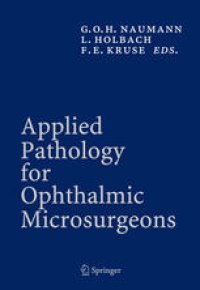
Ebook: Applied Pathology for Ophthalmic Microsurgeons
- Tags: Ophthalmology, Pathology, Surgery, Minimally Invasive Surgery
- Year: 2008
- Publisher: Springer-Verlag Berlin Heidelberg
- Edition: 1
- Language: English
- pdf
Ophthalmic microsurgery is applied in ophthalmic pathological conditions. Ophthalmic pathology sets the landmarks for all kinds of microsurgical manipulations. Thus, in order to ensure the best surgical outcome, ophthalmic clinicians and microsurgeons have to consider the critical structures and potential complications before they start with the surgical procedure.
Written by the world famous expert G. O. H. Naumann, this excellent textbook emphasizes the ocular structures such as the nuances of morphology, surgical anatomy, and pathology.
The content includes: Unique features of closed system intraocular surgery in closed system and open eye surgery.- Crucial aspects of restoring the anterior chamber, includes such as the role of blood-ocular barriers and effects of paracenthesis-effects. The spectrum of potential complications in (pseudo-) exfoliation- syndromes as well as the most vulnerable cell populations.- The features of normal and pathologic wound healing in the various tissues after non-mechanical laser and mechanical interventions emergency-pathology requiring prompt surgical intervention.
Brilliant artwork and sketches are further illustrating and summarizing the complex pathology. Thus, the reader will derive great value for the daily routine when learning how the specific pathology modifies the indications and techniques of microsurgery.
Written and edited by the world-famous expert G.O.H. Naumann, this textbook is the first and only on the subject.
It delves into the details of ocular structures such as the nuances of morphology, surgical anatomy and pathology.
The text covers unique features of intraocular surgery in closed system and open eye contexts.
It goes on to cover crucial aspects of restoring the anterior chamber, including the role of blood-ocular barriers and paracenthesis effects.
Then, it delineates the spectrum of potential complications in (pseudo-) exfoliation-syndromes as well as the most vulnerable cell populations.
Readers are also treated to the features of normal and pathologic wound healing after non-mechanical laser and mechanical inventions.
Brilliant artwork and sketches illustrate the complex pathology, adding huge value for the reader in his or her daily routine when they need to know how the specific pathology modifies the indications and techniques of microsurgery.